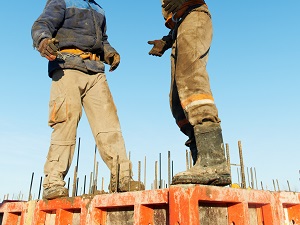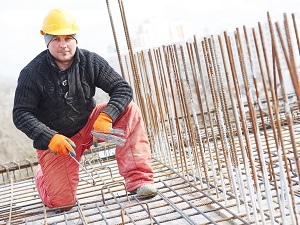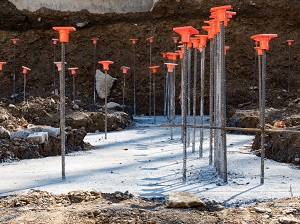Ironworkers have identified impalement as one of the Deadly Dozen Hazards 1 and a leading cause of injury on construction sites.
Contributing factors that can lead to impalement incidents include:
- Unprotected rebar dowels
- Reliance on mushroom caps, which don’t protect workers from impalement
- Improper wooden trough installment
- Inadequate precautions when working over dowel covers
- Inattention to other impalement hazards besides rebar

There are three OSHA Standards that provide the regulations to protect workers from all impalement hazards on the job site.
There is one OSHA standard that very specifically applies to rebar impalement hazards.
OSHA Standard 1926.701(b) All protruding reinforcing steel, onto and into which employees could fall, shall be guarded to eliminate the hazard of impalement.
Housekeeping issues can increase impalement risk if hazards are not managed throughout the workday.
OSHA Standard 1926.25(a) During the course of construction, alteration, or repairs, form and scrap lumber with protruding nails, and all other debris, shall be kept cleared from work areas, passageways, and stairs, in and around buildings or other structures.
It’s important to remember that rebar is not the only impalement hazard found on construction sites. Other impalement hazards not specifically mentioned in the OSHA standard, like protruding pipes, bolts, reinforcing wire, and cables are covered under the General Duty Clause.
OSHA General Duty Clause 5(a)(1) Each employer shall furnish to each of his employees employment and a place of employment which are free from recognized hazards that are causing or are likely to cause death or serious physical harm to his employees.
Because impalement is so serious and often catastrophic, or deadly, it’s important that all crew members understand and follow all safety guidelines that pertain to working with rebar and preventing impalement hazards. State OSHA plans and project specific guidelines may be more strict than federal OSHA requirements.

OSHA states that protective devices capable of withstanding at least 250 pounds dropped from a height of ten feet will eliminate the hazard of impalement in most cases. However, as long as a protective device guards protruding rebar enough to eliminate the hazard of impalement, it satisfies the requirements of the standard.
When employees are working at any height above exposed rebar, fall protection and/or fall prevention needs to be in place. Limit access to the work area where formwork, protruding rebar, and rebar cages are present. All workers should be able to recognize when rebar becomes a hazard.
Guarding on rebar impalement hazards must be done when workers will be working around or at any height above exposed rebar, including work situations where the rebar is below grade or in a basement. Plastic mushroom caps that are not reinforced with steel are not adequate enough to protect against impalement.

Common ways to guard rebar to prevent impalement:
- Steel-Reinforced Rebar Caps
- Carnie Caps
- Wooden Troughs
- Bending Rebar
If the rebar caps being used on site are too narrow, not steel-reinforced, or do not meet OSHA’s requirements for protection, the caps will not protect workers from impalement. If a worker falls on rebar with these ineffective caps the impact pressure can still cause a deadly impalement.
Rebar caps that are designed to prevent impalement are typically larger than mushroom caps, square in shape, and fabricated with steel inside that prevents the rebar dowel from penetrating the protective cover.
Wooden or metal troughs can be an effective method to provide impalement protection, but they should be designed and tested to ensure that impalement protection has been documented.
Rebar of any length, any diameter, and any direction (horizontal or vertical) must be guarded when there is the hazard that a worker could fall onto the bar and be impaled (skin pierced).

Impalement hazards are not limited to protruding rebar. Any projection on the job site that is an impalement risk must be guarded.
Angle iron and other impalement hazards on site may not be suitable for protective covers so consideration must be given to how workers will be protected from impalement risk while the hazard exists during construction.


